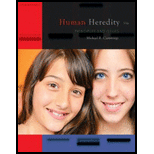
Concept explainers
Antibiotics and Protein Synthesis
Antibiotics are molecules produced by microorganisms as defense mechanisms. The most effective antibiotics work by interfering with essential biochemical or reproductive processes. Many antibiotics block or disrupt one or more stages in protein synthesis. Some of these are mentioned here.
Tetracyclines are a family of chemically related compounds used to treat several types of bacterial infections. Tetracyclines interfere with the initiation of translation. The tetracycline molecule attaches to the small ribosomal subunit and prevents binding of the tRNA anticodon during initiation. Both eukaryotic and prokaryotic ribosomes are sensitive to the action of tetracycline, but this antibiotic cannot pass through the plasma membrane of eukaryotic cells. Because tetracycline can enter bacterial cells to inhibit protein synthesis, it will stop bacterial growth, helping the immune system fight the infection.
Streptomycin is used in hospitals to treat serious bacterial infections. It binds to the small ribosomal subunit but does not prevent initiation or elongation; however, it does affect the efficiency of protein synthesis. Binding of streptomycin changes the way mRNA codons interact with the tRNA. As a result, incorrect amino acids are incorporated into the growing polypeptide chain, producing nonfunctional proteins. In addition, streptomycin causes the ribosome to randomly fall off the mRNA, preventing the synthesis of complete proteins.
Puromycin is not used clinically but has played an important role in studying the mechanism of protein synthesis in the research laboratory. The puromycin molecule is the same size and shape as a tRNA/amino acid complex. When puromycin enters the ribosome, it can be incorporated into a growing polypeptide chain, stopping further synthesis because no peptide bond can be formed between puromycin and an amino acid, causing the shortened polypeptide to fall off the ribosome.
Chloramphenicol was one of the first broadspectrum antibiotics introduced. Eukaryotic cells are resistant to its actions, and it was widely used to treat bacterial infections. However, its use is limited to external applications and serious infections. Chloramphenicol destroys cells in the bone marrow, the source of all blood cells. In bacteria, this antibiotic binds to the large ribosomal subunit and inhibits the formation of peptide bonds. Another antibiotic, erythromycin, also binds to the large ribosomal subunit and inhibits the movement of ribosomes along the mRNA.
Almost every step of protein synthesis can be inhibited by one antibiotic or another. Work on designing new synthetic antibiotics to fight infections is based on our knowledge of how the

Questions
Why is targeting protein synthesis an effective strategy for preventing infection?
Want to see the full answer?
Check out a sample textbook solution
Chapter 9 Solutions
Human Heredity: Principles and Issues (MindTap Course List)
- This practice question is from the textbook "Genetics: From Genes to Genomes". It is chapter 13, question 9. a. Which two of the breakpoints could yield a deletion? b. Write the sequence and polarity of a 16-base primer that, in conjunction with primer A, will allow you to diagnose the presence of a deletion in a patient’s genomic DNA. The evidence should be positive, not negative. (That is, you will see a PCR product whose presence and/or size is specific to the deletion; the absence of a band is not informative.) c. Which two of the breakpoints could yield an inversion? d. Write the sequence and polarity of a 16-base primer that, in conjunction with primer A, will allow you to diagnose the presence of an inversion in a patient’s genomic DNA. Your answer should show the primer that would yield the longest possible diagnostic PCR product. Your primer cannot cross any of the red lines. e. Which two of the breakpoints could yield a reciprocal translocation? (Two possible answers exist;…arrow_forwardMyoD is a transcriptional factor that acts specifically in muscle cells. It is hypothesized that Id proteins indirectly repress the transcription of muscle-specific proteins by inhibiting the function of MyoD. Which of the following are mechanisms by which Id proteins act as indirect repressors? (choose all that applies) Compete with activators for access to an enhancer. Bind the activation domain of an activator bound to an enhancer. Bind to activators and hold them in the cytoplasm. Form heterodimers with activators and lessen the homodimers of activators. Please explain each answer choice please.arrow_forwardWeek 4 Rodney Balbo's Imaging servicearrow_forward
- "Which of the following about transposable elements (TEs) is false?" RNA transposons move using an RNA intermediate. DNA transposons make up 3% of the human genome but are disruptive. Genes can move within the same chromosome via TEs. The Drosophila P element can only move in germline cells. Can you explain each answer choices pleae?arrow_forwardWhat will control the rate of bioremediation of petroleum? (Choose all correct answers) The availability of the petroleum The temperature of the water The availability of oxygen The percent of the population that has degraded petroleum in the pastarrow_forwardWhich of the following would lead to a false negative result in a sandwich ELISA (the lab manual refers to this as a direct ELISA- also known as search for antigen)? Mark all correct answers. antibody was non-specific and bound to something other than the antigen of interest. too short of a duration when incubating the reagents in the plate. If there are multiple strains of the pathogen of interest and the antibody does not recognize one of the strains. Did not sample the correct bodily fluid/area to detect the antigen concentration of antigen was too low to detect in the patient sample. inadequate washing was performed after the enzyme linked antibody was allowed to bind. substrate was exposed to too much light reusing a pipette that was used to pipette a positive sample.arrow_forward
- S. +1269 pts /1500 © Macmillan Learning 0 Resources Solution Penalized Feedback Try Again Draw the final product with stereochemistry and lone pairs. The leaving group has been pre-drawn for your convenience. +100 +100 : 0: + H,C- :0: : 0 0 : +100 +94 possible ✓ +100 K Attemparrow_forward+1269 pts /1500 © Macmillan Learning t/1188d950-dd73-11e0-9572-0800200c9a66/3045511b-267e-4a00-86ca-85dbc62ecb4e/6ac3a0c9-... a □ 出 All Bookmarks Due: Mon, May 26 Resources Solution Penalized Feedback Try Again KX Attempt 3 Draw the final product with stereochemistry and lone pairs. The leaving group has been pre-drawn for your convenience. :0: + нс H,C- :0: : 0:arrow_forwards. +1169 pts /1500 © Macmillan Learning 0 Resources Hint Submit Answer Step 3: This tertiary carbocation intermediate readily undergoes elimination with any weak base to form two possible products. + + H :0: H +94 possible 3a) Draw the minor organic product of elimination. Select Draw Templates More +100 +95 possible # C Major product + Minor product 3b) Draw the major organic product of elimination. Erase Select Draw Templates More C Erasearrow_forward
- Explain the Science & Society on (with links and pictures): ---- Question down below Discuss the ethical, medical, and societal implications of using advanced genetic techniques?arrow_forwardExplain the Disease Mechanism & Impact on (with links and pictures): What causes Leigh Syndrome and why it's so deadly. Which cellular functions, organelles (especially mitochondria), and macromolecules are involved.arrow_forwardExplain the Disease Mechanism & Impact on (with links and pictures): What's going wrong inside the cell and the effects on the human body. Describe metabolism with an emphasis on cellular respiration.arrow_forward
 Human Heredity: Principles and Issues (MindTap Co...BiologyISBN:9781305251052Author:Michael CummingsPublisher:Cengage Learning
Human Heredity: Principles and Issues (MindTap Co...BiologyISBN:9781305251052Author:Michael CummingsPublisher:Cengage Learning Biology (MindTap Course List)BiologyISBN:9781337392938Author:Eldra Solomon, Charles Martin, Diana W. Martin, Linda R. BergPublisher:Cengage Learning
Biology (MindTap Course List)BiologyISBN:9781337392938Author:Eldra Solomon, Charles Martin, Diana W. Martin, Linda R. BergPublisher:Cengage Learning Biology 2eBiologyISBN:9781947172517Author:Matthew Douglas, Jung Choi, Mary Ann ClarkPublisher:OpenStax
Biology 2eBiologyISBN:9781947172517Author:Matthew Douglas, Jung Choi, Mary Ann ClarkPublisher:OpenStax Biology Today and Tomorrow without Physiology (Mi...BiologyISBN:9781305117396Author:Cecie Starr, Christine Evers, Lisa StarrPublisher:Cengage Learning
Biology Today and Tomorrow without Physiology (Mi...BiologyISBN:9781305117396Author:Cecie Starr, Christine Evers, Lisa StarrPublisher:Cengage Learning Biology: The Dynamic Science (MindTap Course List)BiologyISBN:9781305389892Author:Peter J. Russell, Paul E. Hertz, Beverly McMillanPublisher:Cengage Learning
Biology: The Dynamic Science (MindTap Course List)BiologyISBN:9781305389892Author:Peter J. Russell, Paul E. Hertz, Beverly McMillanPublisher:Cengage Learning Concepts of BiologyBiologyISBN:9781938168116Author:Samantha Fowler, Rebecca Roush, James WisePublisher:OpenStax College
Concepts of BiologyBiologyISBN:9781938168116Author:Samantha Fowler, Rebecca Roush, James WisePublisher:OpenStax College





